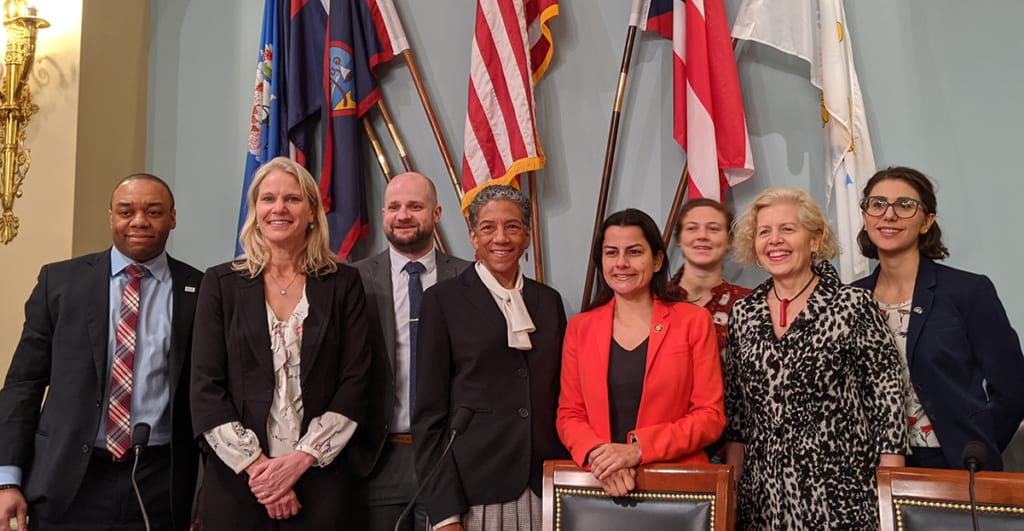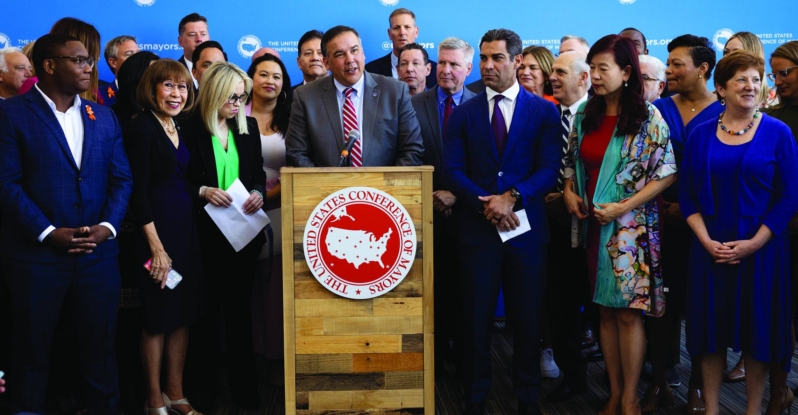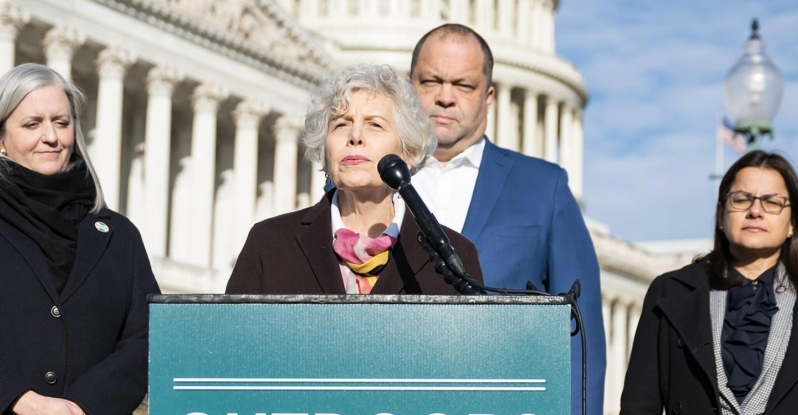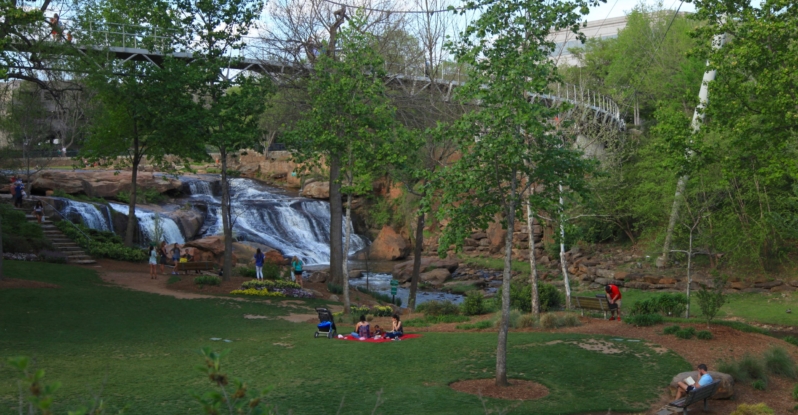
On February 27th, 2020, Executive Director of Denver Parks and Recreation and City Parks Alliance Board Member Happy Haynes testified before the House Natural Resources Committee, the Subcommittee on National Parks, Forests, and Public Lands in support of H.R. 4512, the Outdoors for All Act. The full transcript of her testimony is below. Pictured above: Joel Pannell (Sierra Club), Julie Waterman (City Parks Alliance), Kyle Simpson (National Recreation and Park Association), Happy Haynes (Denver Park & Rec.), Rep. Nanette Diaz Barragán (D-CA), Francesca Governali (The Wilderness Society), Catherine Nagel (City Parks Alliance), Tara Brown (The Wilderness Society).
Dear Chairwoman Haaland, Ranking Member Young, and Members of the House Subcommittee on National Parks, Forests and Public Lands:
I thank you for the opportunity to testify before you today in support of the Outdoors for All Act (H.R. 4512) and share my story about access to the great outdoors. I am Happy Haynes, a Denver native, fourth-generation Coloradoan, and Executive Director of the City and County of Denver Parks and Recreation Department. I am excited to support this critical legislation that will significantly improve close-to-home access to nature, making our cities healthier, safer and more connected.
I’d like to share a little of my own story with you. While I was growing up in Denver, by chance I came upon a small box canyon in a park that I frequently cut through to get to school. At first, it was kind of scary and forbidding especially since I was supposed to be walking on sidewalks along the streets in plain view. Eventually, I ventured into the little canyon and soon it became my imaginary jungle with wild beasts and rivers and exotic plants far from the civilized world. I even coaxed some of my classmates into joining me on the journey. We were constantly late for school and convinced that we were breaking some rule by exploring that space. That chance encounter is a big part of the reason why I am here speaking to you today.
In addition, I had a grandmother who grew up in rural northern New Mexico and created a garden in our backyard where I was encouraged to play in the dirt. It was the only garden in our neighborhood. Although growing up we could see the majestic Rocky Mountains looming over downtown Denver from my community, they might as well have been on the moon, they were so disconnected from our lives.
Then, in 1965 the Head Start program in Colorado hosted a summer camp for a few low-income families in the mountains just outside of Denver and again by chance, I had the opportunity to experience nature and learn about Snipe hunts and s’mores. Finally, when I was a senior in high school, my wonderful principal, who was one of the founders of Colorado Outward Bound, created a special experiential education program for a handful of students that took us to the canyons of Mexico, the Navajo reservation and rafting on the Yampa River. I fell in love with
nature and outdoor adventure.
All these rare and random experiences led me to be one of the founders of the environmental youth corps in Colorado, to serving on the State Parks Board and on the boards of the Trust for Public Land, The Nature Conservancy and City Parks Alliance and to my role in Denver Parks and Recreation today. I should not still be such a rare bird – an African American woman, urban dweller, and an outdoor recreation enthusiast.
In Denver, we are on a mission to make sure your race, income and zip code don’t affect your access to nature to ensure that stories and experiences like mine are neither rare nor by chance. The Outdoors for All Act would greatly help with this mission.
The Outdoors for All Act would codify the Outdoor Recreation Legacy Partnership Program (ORLP). Congress created the ORLP in 2014, recognizing that too few conservation dollars were being granted to help underserved urban communities with their park and recreation needs. The ORLP is a National Park Service (NPS) competitive grant program and is funded through the Land and Water Conservation Fund (LWCF) State and Local Assistance Program. Unfortunately, LWCF grants often don’t trickle down to cities, which is why the ORLP program is so important. These grants help cities address outdoor recreation deficits by supporting projects that create new outdoor recreation spaces and renovate existing ones. While relatively small, the ORLP is often just the shot in the arm needed to get important projects off the ground or to close funding gaps to carry park projects over the finish line. However, the ORLP is subject to annual appropriations, meaning the program is not consistently funded. To ensure that cities can rely on the ORLP, there needs to be mandatory funding, as would be enacted by the Outdoors for All Act. The need for parks and close-to-home recreation has never been greater. Cities need a dedicated source of park funding so that future generations have healthy, vibrant communities.
Since 2014, the National Park Service has awarded ORLP grants to 49 communities in 29 states for the expansion of outdoor recreation opportunities. Thanks to the ORLP, Denver Parks and Recreation has begun the important work of expanding access to nearby nature, particularly for our underserved communities. With an average of 300 sunny days each year and the Rocky Mountains as its backyard, Denver is the perfect place to recreate in the outdoors. More than 700,000 people call Denver home and 100,000 of them have moved to our city just in the past decade. While there are many factors that contribute to Denver’s popularity, the ability to play in Colorado’s great outdoors remains at the top of the list. Our state is famous for its natural splendor and outdoor sporting heritage.
However, the reality is that access to nearby nature and outdoor adventures remains extremely challenging to many families living in our city’s historically underserved communities. Despite the enormous economic, physical, mental and environmental benefits that parks provide, public funding for parks — especially in distressed communities where their multiple benefits are most needed — is limited and not keeping up with demand. Historic disinvestment has left many low-income communities and communities of color without access to quality parks and recreation opportunities and with park assets in need of significant upgrades.
Cities struggle with the strain of high healthcare costs due to obesity, diabetes and heart disease. Research tells us that having parks in our neighborhoods, near where residents live, provides immense health benefits. These benefits include a reduced risk of type II diabetes, heart disease, preterm birth, and premature death. People living close to nature also tended to have a more restful night’s sleep, have lower levels of stress and report being in good health (1).
A recent report by the Outdoor Foundation concluded that nearly half the U.S. population did not participate in any outdoor recreation in 2018. Partnering with municipalities across the country, the ORLP can curb these alarming numbers by continuing to provide access to the outdoors and opportunities to recreate, not only in Denver but across the country.
One of Denver’s newest jewels is the Montbello Open Space Park. One of the first-ever ORLP grant recipients in 2015, this project leveraged other local and private dollars to build a 5-acre park in a historically underserved community, improving park access for 3,725 people within a 10-minute walk. By almost any measure (race, ethnicity, age), Montbello is a very diverse community. Nearly 90 percent of residents identify as an individual of color and 59 percent speak a language other than English at home (2). Montbello is also a family-oriented neighborhood. The average household size in Montbello is much larger than the rest of Denver, and the median age is much lower — about 34 percent of the population is under the age of 18 (2). In this neighborhood, it is common for large or multi-generational families to live together under the same roof. Family incomes in Montbello are significantly lower than the rest of Denver, with 21 percent of residents living below the poverty line, and over 90 percent of children receiving free or reduced-price lunch at Denver Public Schools.2,3 The neighborhood also suffers from some of the other health and educational disparities associated with poverty. Forty percent of children in the area are overweight or obese, more than one-third of the adult population does not hold a high school diploma, and the neighborhood ranks in the bottom 15 percent in terms of access to health services in the city (4, 5, 6).
While the Montbello neighborhood in northeast Denver has historically experienced inequitable access to public parks, the Montbello Open Space Project presented an opportunity to both better serve Montbello families and improve natural areas. Through a partnership with Denver Parks and Recreation, The Trust for Public Land (TPL), and Environmental Learning for Kids (ELK), we are using an ORLP grant to transform this once-neglected vacant property into a natural open space and outdoor learning laboratory. This Montbello Open Space Park is being restored to native short grass prairie with trails, artwork, an outdoor classroom, and nature play experiences along with a custom rock-climbing boulder that local students helped design.
Ironically, the edge of the Rocky Mountain Arsenal National Wildlife Refuge is adjacent to the neighborhood, but because of its enormous scale and no nearby entrances for the neighborhood, it remains largely inaccessible to this low-income community right next door. Our goal is to use the education and experiences of the Montbello Open Space to draw this community towards its neighboring wildlife refuge as well as rivers, mountains and other beautiful areas of our state. While this park is not a silver bullet to solving all the neighborhood issues, it is a step in the right direction and one that was only made possible through the Outdoor Recreation Legacy Partnership Program. Chris Urias from the Montbello neighborhood encapsulates the impact local parks can have in our communities.
Chris has shared that, “For youth and families living in Montbello–one of Denver’s most economically distressed communities – lack of exposure and access to the outdoors limits them to establishing potential interests and careers; to physical activity and play; to the discovery of themselves. When a person must leave his or her neighborhood to experience nature, they develop the impression that nature is always something ‘out there,’ not part of their reality…I can see the Rocky Mountains from my front door but getting out there is not a reality.”
Through the Montbello project, access to a quality outdoor experience is possible and Chris is excited that this once empty place is now a safe place close to home where he can learn and explore. In Denver, we consider the Montbello Open Space Park a major success and recognize there is still much more work to be done in similar communities across Denver and in other cities across the state and country, which is why the continuation of the Outdoor Recreation Legacy Partnership Program is so important.
Since 2014 an additional 48 communities across the country have received ORLP grants. Some examples of these projects include the development of Muldoon Town Square Park in Anchorage, Alaska, that will construct an inclusive playground and all-season path loop; transformation of a vacant property in Atlanta, Georgia that connects an underserved neighborhood to the BeltLine trail network; the development of 13 acres of new parkland along the Delaware River waterfront to improve access for nearby distressed and underserved communities in Camden, New Jersey; and the development of a new 3.5-acre park on a former industrial site along the Mississippi River in a low-income neighborhood in Minneapolis, Minnesota.
As cities continue to grow, the need for increased urban park funding is more important than ever. Denver’s population is projected to increase by another 150,000 residents in the next 10 years. While this growth will bring many benefits to the city, it will also add pressure on its already strained parks and recreation system. Denver will need new, resilient park space and programming resources to meet this growing demand. In fact, Denver Parks and Recreation recognizes parks as infrastructure vital to Denver’s health. Adopted in May 2019, Game Plan for a Healthy City is a citywide and long-range parks and recreation plan to help Denver respond to challenges associated with growth and climate change. The plan proclaims easy access to parks and open space as a basic right for all residents and establishes our city’s parks, facilities and recreational programs as essential for a healthy environment, healthy residents, and a high quality-of-life for everyone.
A critical part of building a healthy city includes adapting to climate change, enhancing biodiversity, and improving stewardship of our resources to ensure vital parks infrastructure is resilient and sustainable. Today, the Denver region is experiencing an increase in temperatures, more storms with flooding, and longer periods of drought. Future summers are predicted to be hotter, with an average high of 96 degrees — more like summers in south Texas today (7). To meet this challenge, Game Plan for a Healthy City offers strategies for water use and drought-tolerant landscapes, stormwater and waterway health, increasing urban tree canopy and mountain forests, and efficient use of limited resources.
Urban parks function as dual-use spaces for both recreation and green stormwater management, such as a rain garden — harmonizing the natural and built environments and creating resilient communities. Rain gardens are designed to soak up millions of gallons of rainwater to reduce combined sewer overflows (CSOs). CSOs discharge untreated wastewater and stormwater, often containing agricultural runoff and toxic substances, directly into nearby bodies of water. As one of the leading sources of pollution in the nation, CSOs put the public health of communities and local ecosystems at great risk. Green infrastructure systems use the natural environment to manage stormwater and provide co-benefits to the community, including improved water quality and cost competitiveness compared to gray forms of infrastructure.
Not only do local parks provide health benefits and climate-resilient spaces, but they also spur economic growth. Investments in community parks help grow local economies by creating jobs and attracting the kinds of businesses, workforces, and private capital that make metropolitan areas competitive in today’s global economy. ORLP funding is an essential resource for cities as they seek to develop new or revitalize existing urban parks, green spaces, and recreation opportunities. Local communities and parks departments like ours cannot do it alone. The ORLP is the only federal program focused exclusively on supporting parks and outdoor recreation opportunities in cities where 80% of Americans live (8). It is important to codify this program by passing the Outdoors for All Act.
In summary, access to nature is a human right. Vibrant communities that thrive for generations need access to parks, trails and green spaces. In addition to providing residents with valuable, enriching connections with nature, outdoor recreation provides opportunities to foster an appreciation for public lands, creating stewards of our region’s limited natural resources. The LWCF, and its Outdoor Recreation Legacy Partnership Program, are smart investments in achieving this end, strengthening our communities and our national health and resiliency. Congress should seize this moment and pass the Outdoors for All Act.
1 Twohig-Bennett, C and A Jones, Journal of Environmental Research. The health benefits of the great outdoors: A
systematic review and meta-analysis of greenspace exposure and health outcomes.
https://www.ncbi.nlm.nih.gov/pubmed/29982151, 2018.
2 Shift Research Lab, The Piton Foundation. “Montbello Community Facts.”
https://denvermetrodata.org/neighborhood/montbello, 2017.
3 Public School Review. “Public School Eligible for Free Lunch in Colorado.”
https://www.publicschoolreview.com/free-lunch-stats/colorado, 2020.
4 Colorado Health Observation Regional Data Service. Maps of Select CHORDS Indicators.
https://www.cohealthmaps.dphe.state.co.us/chords_maps/chords_webmap/, 2019.
5 Shift Research Lab, The Piton Foundation. “Montbello Community Facts.”
https://denvermetrodata.org/neighborhood/montbello, 2017.
6 Denver Community Planning and Development Department, Far Northeast Area Plan.
https://www.denvergov.org/media/denvergov/cpd/Far_Northeast_Area_Plan.pdf
7 Western Water Assessment, University of Colorado Boulder. “Climate Change and Projections.”
https://wwa.colorado.edu/climate/change.html, 2019.
8 Center for Sustainable Systems, University of Michigan, “U.S. Cities Factsheet”,
http://css.umich.edu/factsheets/us-cities-factsheet, 2018.



